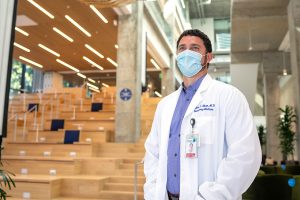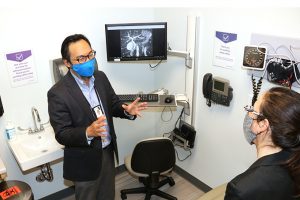Feature story:
Searching for evidence to guide COVID-19 care
In April 2020, physician scientist Adam Sharp, MD, MSc, spent his emergency department shifts working in an ambulance bay at the Kaiser Permanente Los Angeles Medical Center, where he evaluated patients who came in seeking care for symptoms that could be COVID-19.
Dr. Sharp recalled, “I remember sitting there, in all my protective gear, thinking, ‘How am I supposed to know which of these patients might be most at risk and who really needs to be admitted to the hospital?'”
Emergency physicians across the globe faced daunting constraints in the early stages of the pandemic. Limited testing supplies meant that physicians often had to assess which patients needed to be hospitalized for COVID-19 without having a confirmed diagnosis. Even if a rapid test was available, little was yet known about who might be at greatest risk for deterioration.
The concern Dr. Sharp felt while sitting in the triage tent led to an idea for a new research project. Much of his prior research focused on clinical decision tools, including risk scores. Why not develop a risk score to help physicians determine who might benefit most from hospitalization?
Dr. Sharp and his clinical colleagues began to develop an assessment tool that looked at patient comorbidities, obesity, vital signs, age, and sex. Dubbed the COVAS Score, the tool was developed in a matter of months. By July 2020, it was implemented in the Kaiser Permanente HealthConnect® electronic health record.
“I’ve used the tool to make informed decisions with my own patients in the emergency room,” Dr. Sharp said. “It can help to reassure low-risk patients, and alternatively can encourage those at high risk to receive hospital-based care that may speed their recovery.”
Interest in research surged during pandemic
Dr. Sharp was far from alone in turning to research to resolve the many unanswered questions about COVID-19. Physicians at Kaiser Permanente medical centers across Southern California began to explore ideas for potential research projects. In the early stages of the pandemic, many reached out to Bechien U. Wu, MD, MPH, and other members of the Regional Research Committee.
“The situation with COVID-19 highlighted the important role that research can play,” said Dr. Wu, who chairs the committee. “We were dealing with an entirely new disease, with many gaps in our knowledge.”
As interest in COVID-19 research surged, concerns arose that projects would overlap and that limited research resources, including our programmers and biostatisticians, would be stretched too thin.
In March, Dr. Steven Jacobsen, then senior director of research, asked epidemiologist Annette Adams, PhD, MPH, to help track COVID-19 research and consult on as much study design as she could. An initial list gathered through phone calls, email inquiries, and an online survey included about 80 study ideas. Dr. Adams discovered significant overlap in research interests, from racial and ethnic disparities to risks and outcomes for pregnant women.
“Some of what I did was matchmaking,” said Dr. Adams. “If I heard several investigators expressing a similar idea, I would connect them.”
Matching clinicians and researchers
Meanwhile, Dr. Wu began to do some matchmaking of his own. He saw an opportunity to bring clinicians and researchers together to initiate a series of rapid-cycle research projects. The idea was to conduct research that could be swiftly incorporated into practice.

“We were fielding calls left and right, so it seemed like a natural fit,” he said. “We had piloted the concept of rapid-cycle research projects a few years earlier, so we already had a model for accelerated review as well as a funding stream.”
At the end of March, Dr. Wu reached out to Michael K. Gould, MD, MS, then director of the Division of Health Services Research and Implementation Science and leader of the Care Improvement Research Team (CIRT), a group with expertise in bringing together clinicians and researchers to answer important questions and improve care. Dr. Gould quickly agreed.
“We had an opportunity to address urgent research questions and inform our frontline clinical partners, which is the core of our mission as researchers embedded within the care delivery system,” said Dr. Gould.
Clinical groups, including emergency physicians, hospitalists, and pulmonologists, reached out with clinical questions. Several research scientists also proposed research ideas.
“There were many unanswered questions about COVID-19, including how to assess and manage risk for patients with suspected or confirmed COVID-19,” said George Yuen, MD, regional chief of pulmonary and critical care medicine. “We hoped these studies would shed much-needed light on the risk factors for severe disease and help inform clinical decisions for our patients.”
Rapid-cycle research meets urgent demand
The rapid-cycle project team brought together nearly 2 dozen scientists and physicians from a wide range of specialties, including pulmonary and critical care, hospital medicine, emergency medicine, cardiology, nephrology, internal medicine, family medicine, pediatrics, neurology, and immunology.
Of the 4 initial projects, 3 have resulted in new clinical decision tools. The first was Dr. Sharp’s COVAS model. Early 2021 saw the implementation of 2 tools, one to estimate mortality risk for patients on mechanical ventilation and one to predict which hospitalized patients are at risk for deterioration.
Even as the first project began to find answers, new questions continued to emerge. In December 2020, regional leaders approved a new round of CIRT projects, including studies focused on household transmission, equitable risk-stratification tools, and understanding and supporting COVID-19 vaccine confidence among health care providers at Kaiser Permanente Southern California. The Regional Research Committee also supported 5 additional COVID-19 research projects.
Evaluating swabs, saliva to scale up testing
One of the RRC-funded studies was a clinical evaluation of different sample types for SARS-CoV-2 molecular diagnostic testing. Christopher Tenggardjaja, MD, a urologist at Kaiser Permanente Los Angeles Medical Center, initially became interested in the topic for personal reasons. He and his wife were expecting their third child and Kaiser Permanente had recently begun using rapid molecular tests to routinely screen expectant mothers before admission to the hospital.
COVID-19 testing most often involves nasopharyngeal and/or oropharyngeal (NP/OP) swabs, which are inserted deep into the nose and/or throat and must be collected by a health care provider. At the time, there were supply challenges. Dr. Tenggardjaja began to wonder about other testing options.
“I thought we were well positioned to study the sensitivity, or accuracy, of different testing options in our real-world setting, where performance could differ from highly controlled laboratory studies,” said Dr. Tenggardjaja.
In early April 2020, he reached out to Nancy Gin, MD, regional medical director of Quality and Clinical Analysis, and several other quality and research leaders, who ultimately connected him with Katia Bruxvoort, PhD, MPH, an infectious disease epidemiologist and post-doctoral research fellow, and Jonathan Gullett, MD, physician director of microbiology for the Southern California Permanente Medical Group’s Regional Reference Laboratories.
After exploring several ideas, they initiated a study to determine whether patient-collected saliva or nostril swabs that don’t reach so deep into the nose could be as accurate as NP/OP swabs.
“NP/OP swabs can be really painful for patients, and they have to be administered by a health care provider,” said Dr. Bruxvoort. “There was a need for more flexible options to help scale up testing.”
Other options for testing could help with both supply challenges and safety.
“Another advantage to saliva collection is that it does not rely on swabs or commonly used transport media, both of which have been in relative short supply globally since the beginning of the pandemic,” said Dr. Gullett. “Self-collection, whether at home or in drive-through locations, also offers a safer alternative to both patients and providers alike from the potential further spread of disease.”
Data lead to changes in regional lab strategy, EUA application
In mid-August, the research team launched the study. Patients with COVID-19 symptoms who had orders for the NP/OP test were invited to participate by providing self-collected saliva and nostril swabs. More than 2,000 patients enrolled at 7 Kaiser Permanente emergency departments. The Regional Reference Laboratory team worked closely with the study team to optimize the workflow for testing saliva and nostril swabs. They processed the samples and provided data files daily.
In October, the study team presented its interim results to Dr. Gin and Benjamin Broder, MD, PhD, regional assistant medical director of Quality and Clinical Analysis. The region was in the midst of planning to manage potentially monumental demand for testing in the late fall and winter months.
“Even though our lab capacity had increased, the kind of demand we anticipated would require a lot of personnel, right when we would likely need more people to support direct patient care,” said Dr. Broder. “We were very interested in exploring other testing options.”
Based on the interim results, the regional leaders decided to start using patient-collected saliva at drive-through centers in mid-November. Near the end of the year, the lab team submitted an emergency use application to the Food & Drug Administration, seeking approval to use saliva tests at home, which it received in April 2021.
“Our researchers provide essential insights to our organization by finding evidence that isn’t yet available in the published literature,” said Dr. Gin. “This has been more essential than ever during the pandemic as we deal with a still-new disease with so many unanswered questions.”





